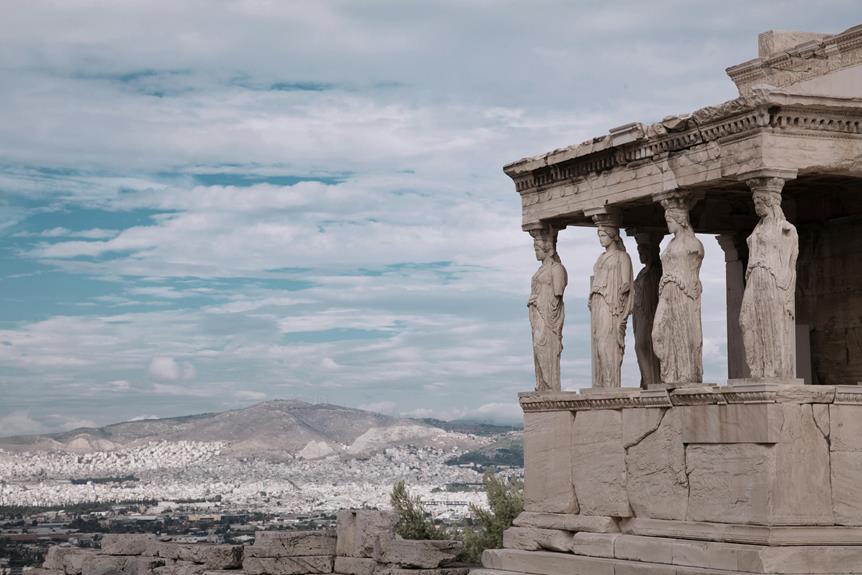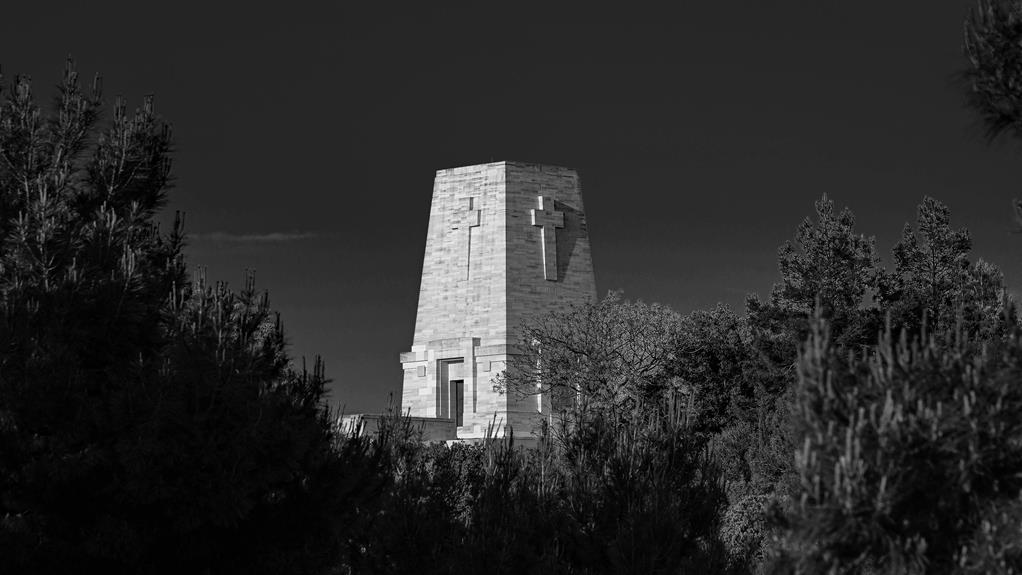The Tangshan Earthquake Memorial in China stands as a solemn affirmation to the devastating impact of natural disasters on communities. Beyond its architectural significance, the memorial serves as a site of remembrance and reflection, allowing visitors to contemplate the fragility of life and the resilience of the human spirit in the face of adversity. As we explore the memorial's design and symbolism, we are prompted to ponder the broader implications of such tragedies and the role of commemorative spaces in honoring the past while shaping the future.
Key Takeaways
- Blend of modern and traditional Chinese architecture.
- Symbol of remembrance for 1976 earthquake victims.
- Promotes harmony and tranquility in design.
- Located amidst ruins to symbolize resilience.
- Beacon of hope for future generations.
History of the Tangshan Earthquake
The genesis of the catastrophic Tangshan earthquake can be traced back to a series of geological events that culminated in one of the deadliest natural disasters in recorded history. On July 28, 1976, at 3:42 am local time, the city of Tangshan in Hebei Province, China, was struck by a massive earthquake measuring 7.6 on the Richter scale. The causes of this devastating seismic event were attributed to the complex tectonic plate movements in the region, specifically the interaction between the Eurasian Plate and the Philippine Sea Plate.
The aftermath of the Tangshan earthquake was nothing short of catastrophic. Official reports estimate that the death toll exceeded 240,000 people, making it one of the deadliest earthquakes in modern history. The city of Tangshan was almost entirely leveled, with buildings reduced to rubble and infrastructure destroyed. The impact of the earthquake was felt far and wide, with aftershocks continuing for months, further hampering rescue and recovery efforts.
The aftermath of the Tangshan earthquake led to significant changes in China's approach to disaster preparedness and response. It highlighted the importance of stringent building codes, early warning systems, and emergency response protocols. The memory of this tragic event is commemorated at the Tangshan Earthquake Memorial, a somber reminder of the lives lost and the resilience of the survivors.
Design and Architecture of the Memorial
Nestled within the serene landscape of Tangshan, the Earthquake Memorial stands as a poignant demonstration to the resilience of the human spirit in the face of tragedy. The design and architecture of the memorial are intricately crafted to evoke emotions and honor the lives lost during the devastating earthquake.
Architectural elements play a vital role in the design of the Tangshan Earthquake Memorial. The main structure features a combination of modern and traditional Chinese architectural styles, symbolizing a bridge between the past and the present. The use of materials like stone and concrete not only provides durability but also signifies strength and stability. The layout of the memorial is carefully planned to create a sense of harmony and tranquility, offering visitors a space for reflection and remembrance.
One of the highlights of the memorial is the sculpture garden, which showcases a collection of artworks created by renowned artists. These sculptures depict scenes of rescue efforts, rebuilding processes, and the unwavering spirit of the survivors. The placement of each sculpture within the garden is thoughtfully done to enhance the overall aesthetic and emotional impact on visitors.
Symbolism and Significance of the Memorial
Crafted with meticulous attention to detail, the Tangshan Earthquake Memorial embodies profound symbolism and significance that resonate with visitors from around the world. The memorial stands as a symbol of remembrance, honoring the lives lost during the devastating 1976 earthquake in Tangshan, China. The design and layout of the memorial are not just architectural feats but also bear deep symbolic meanings.
One of the key symbols within the memorial is the use of materials. The contrast between the dark, rough stones representing the tragedy and the smooth, light-colored stones symbolizing hope and resilience creates a powerful visual representation of the journey from despair to healing. Additionally, the layout of the memorial, with its winding pathways and tranquil gardens, encourages visitors to reflect on the past while looking towards a brighter future.
Moreover, the memorial's strategic location, nestled amidst the ruins of the earthquake, serves as a poignant reminder of the city's resilience and the indomitable spirit of its people. By preserving the remnants of the disaster, the memorial not only pays tribute to the past but also serves as a beacon of hope for future generations.
In essence, the Tangshan Earthquake Memorial is more than just a physical structure; it is a living affirmation to the enduring power of remembrance and the human spirit's ability to overcome adversity.
Visitor Experience and Facilities
Located within the heart of Tangshan, the visitor experience at the Tangshan Earthquake Memorial is meticulously curated to provide a profound and educational journey for all who come to pay their respects. The memorial offers a range of visitor amenities designed to enhance the overall experience. These include guided tours, informative signage in multiple languages, a gift shop offering relevant literature and mementos, as well as a cafeteria where visitors can relax and reflect.
One of the key highlights of the visitor experience at the Tangshan Earthquake Memorial is the presence of interactive exhibits. These exhibits allow visitors to engage with the history and impact of the 1976 earthquake in a hands-on and immersive manner. Through interactive displays, visitors can gain a deeper understanding of the events leading up to the earthquake, its devastating consequences, and the remarkable recovery efforts that followed.
Furthermore, the memorial provides a serene and contemplative space for visitors to pay their respects to the victims of the earthquake. The layout of the memorial grounds encourages quiet reflection and remembrance, allowing visitors to connect with the significance of the site on a personal level. Overall, the visitor experience at the Tangshan Earthquake Memorial is thoughtfully designed to honor the past and educate future generations about the resilience of the human spirit in the face of tragedy.
Commemorative Events and Activities
The commemorative events and activities at the Tangshan Earthquake Memorial serve to honor the memory of those affected by the devastating earthquake of 1976 through meaningful and engaging experiences. One of the ways this is achieved is through public art installations that convey the magnitude of the disaster and pay tribute to the lives lost. Sculptures, murals, and other artistic expressions within the memorial grounds serve as poignant reminders of the tragedy, fostering reflection and remembrance among visitors.
Educational outreach programs play an essential role in raising awareness about the earthquake's impact and the importance of disaster preparedness. Through guided tours, informative exhibits, and interactive workshops, visitors have the opportunity to learn about the historical context of the earthquake, its aftermath, and the resilience of the Tangshan community in rebuilding. These initiatives not only commemorate the past but also aim to educate present and future generations about the importance of disaster mitigation and response.
Preservation Efforts and Future Plans
In light of ongoing efforts to preserve the historical significance of the Tangshan Earthquake Memorial and enhance its impact as a site for remembrance and education, strategic initiatives are being developed to guarantee the longevity and relevance of the memorial for future generations. Preservation challenges at the Tangshan Earthquake Memorial primarily stem from the natural weathering of the site's structures and the need for continuous maintenance to uphold structural integrity. To address these challenges, preservation experts are working on developing innovative conservation techniques that will protect the memorial's physical elements without compromising its authenticity.
Community involvement plays a vital role in the preservation efforts and future plans for the Tangshan Earthquake Memorial. Engaging local residents, historians, and volunteers in the maintenance and promotion of the memorial fosters a sense of ownership and responsibility among the community members. By organizing community events, educational programs, and volunteer opportunities, the memorial management aims to create a sustainable framework for the ongoing preservation of this significant historical site.
Looking ahead, future plans for the Tangshan Earthquake Memorial include expanding educational initiatives to reach a wider audience, implementing advanced preservation technologies, and enhancing the overall visitor experience. By leveraging community support and embracing technological advancements, the memorial is poised to continue serving as a poignant reminder of the past while offering valuable insights for the future.
Frequently Asked Questions
Can Visitors Participate in Any Earthquake Simulation Experiences at the Memorial?
Visitors seeking disaster preparedness education and interactive experiences can often engage in earthquake simulation activities at memorials worldwide. Such exhibits provide a hands-on approach to understanding seismic events, emphasizing historical significance and fostering educational outreach.
These simulations offer a unique opportunity for visitors to comprehend the impact of earthquakes, promoting awareness and preparedness. Through interactive displays, museums and memorials contribute to public education on the importance of disaster resilience and safety measures.
Are There Any Restrictions on Photography or Filming Inside the Memorial?
Like a still frame frozen in time, the memorial enforces strict photography and filming restrictions to preserve the solemnity of the space. Visitors are kindly reminded to respect these guidelines, ensuring that the memories and significance of the site remain undisturbed.
Is There a Specific Time of Day Recommended for Visiting the Memorial?
The best time to visit the memorial is during quiet hours when there are fewer visitors, allowing for a more contemplative and reflective experience. These times typically include early mornings or late afternoons, depending on the location and operating hours of the memorial.
Choosing a less crowded time can enhance the overall visit by providing a more serene atmosphere for paying respects and absorbing the historical significance of the site.
Are There Any Guided Tours Available for Visitors at the Memorial?
Guided tours at the memorial offer visitors insightful narratives and interactive experiences, enhancing their understanding of the historical significance.
Expert guides lead groups through poignant exhibits, providing detailed information and fostering engagement.
These tours cater to a wide range of interests and knowledge levels, making the visit both informative and engaging.
Embrace the opportunity to explore further into the memorial's story and gain a thorough insight into its profound impact.
Can Visitors Leave Personal Mementos or Tributes at the Memorial Site?
Visitors often seek to leave personal tributes or memorial mementos at significant sites like memorials to honor those impacted by events or to commemorate their own experiences.
The act of leaving such items can serve as a form of remembrance, reflection, or connection to the past. However, guidelines and restrictions may be in place at certain locations to guarantee the preservation and respect of the site.
Conclusion
In the grand tapestry of history, the Tangshan Earthquake Memorial stands as a solemn reminder of the resilience and strength of the human spirit in the face of adversity.
Like a phoenix rising from the ashes, the memorial embodies the enduring legacy of those who perished in the earthquake, serving as a beacon of hope and unity for generations to come.
Its intricate design and profound symbolism continue to inspire visitors to reflect on the fragility of life and the power of collective memory.


